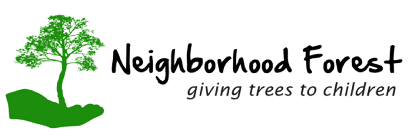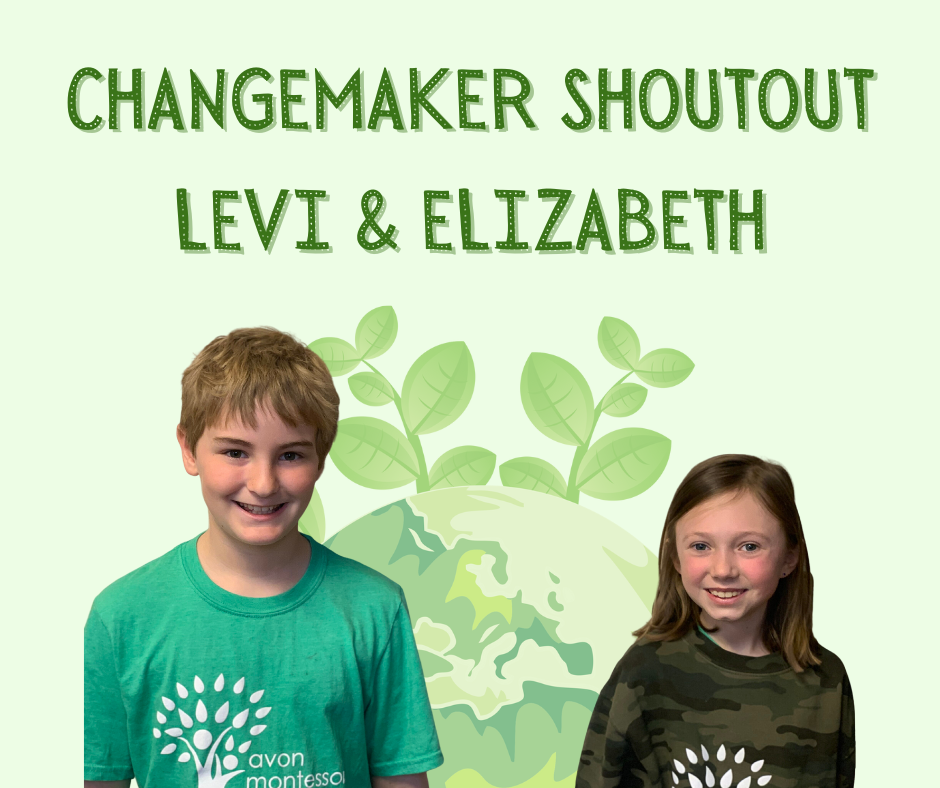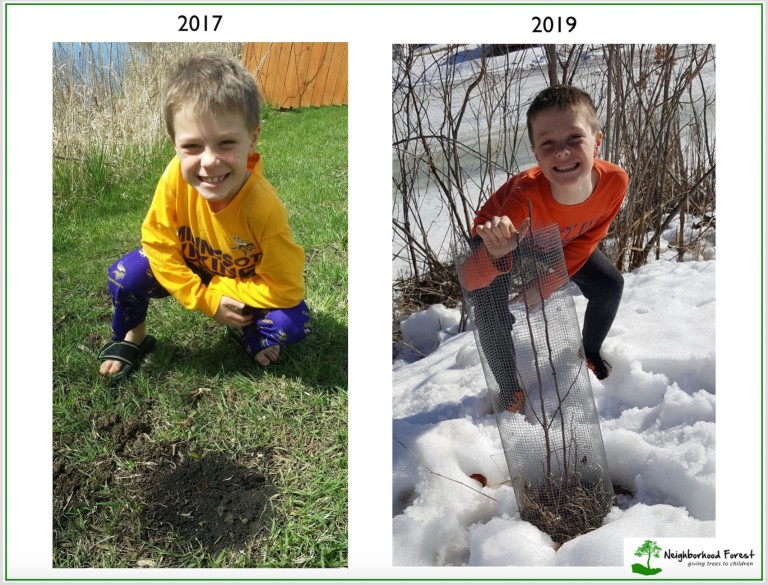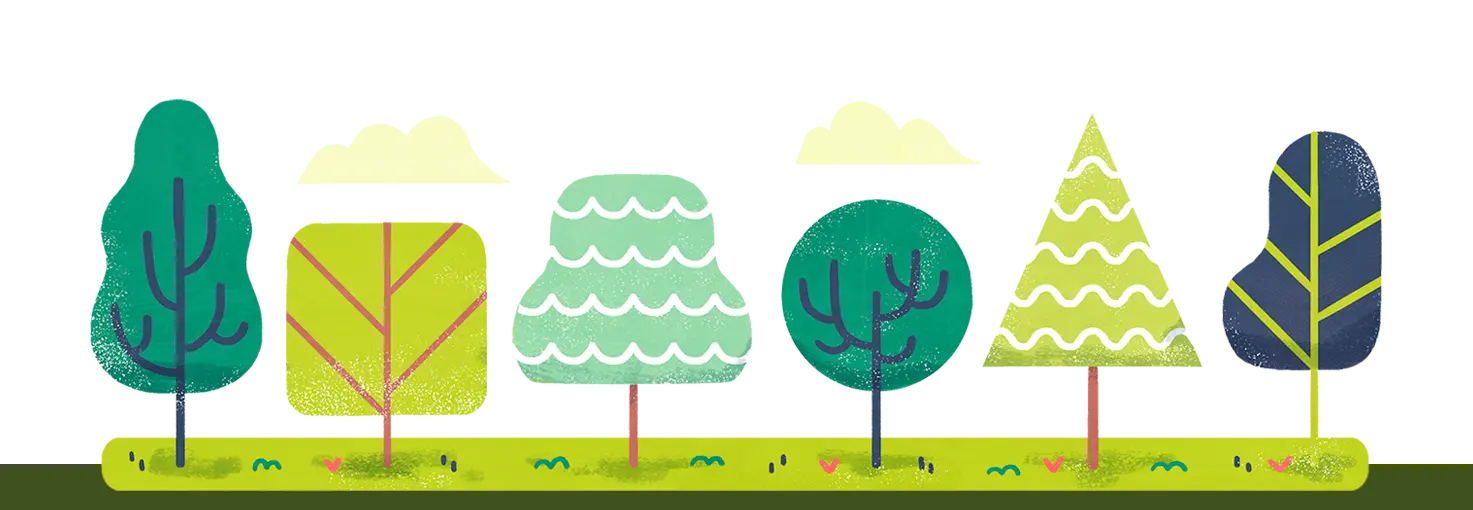Tag: free trees for kids
Changemaker Shoutout! – Levi and Elizabeth
Levi Tracey (4th grade) and Elizabeth Sayler (3rd grade) are two students at Avon Montessori Academy in Avon, Ohio. Together they worked to plan and execute a bake sale raising over $700 dollars to donate to Neighborhood Forest! Julie Felder, Head of the School, interviewed these two students about their wonderful efforts. See their responses below!
WHY DID YOU WANT TO DO A FUNDRAISER FOR NEIGHBORHOOD FOREST?
Levi: It wasn’t always going to be for Neighborhood Forest. At first it was to buy trees and plant them. I found out about Neighborhood Forest through our local library and we did research about them and went on their website. We liked the organization and they have a good mission to get children trees.
Elizabeth: Because we were driving on a field trip and I was sitting with Levi. We saw a lot of garbage outside. And we thought it would be good to do a fundraiser to save the earth because there is a lot of litter and garbage outside.
WHY ARE TREES/THE ENVIRONMENT IMPORTANT TO YOU?
Levi: I like nature, it’s fun to be outside. And I want it to last longer.
Elizabeth: So that we can enjoy being outside instead of being inside. Climbing trees and being outside on nice days is so fun.
WHAT MAKES YOU MOST PROUD OF YOUR FUNDRAISING EFFORTS?
Levi: That we were able to get 150 trees to people through the organization. That’s a lot of trees for a lot of kids – it’s gonna be a lot of trees!
Elizabeth: That we raised a lot of money and a lot of people have supported us.
ANYTHING ELSE TO ADD?
Elizabeth: Thank you to everyone who supported us.
Thanks to Levi and Elizabeth’s generosity and hard work, Avon Montessori Academy will be receiving 100 White Pine Trees for all of their students to plant for Earth Week 2023! The rest of their donation will be used to provide more children trees in our program. We are so deeply touched and moved by this unexpected act of love, generosity, and service by these two young changemakers.
“The mission of Avon Montessori Academy is to cultivate and inspire each individual within the school community to excel as lifetime scholars, creative thinkers, and responsible citizens. Members of our school community act with respect, compassion, integrity, and heart. Weaving the Montessori philosophy with a warm and charming environment, we place emphasis on whole child development, peace education, and care of the Earth.”
Coordinator Program Guide – Guidelines & FAQs
Hello Coordinators!
Please click through our Coordinator Program Guide below to learn more about our program and answer some commonly asked questions.
Thank you for helping us spread joy, beauty, and goodness!
Parent FAQs
Click here for a downloadable version of the Parent FAQs
What kind of tree will we be getting?
-
-
- Neighborhood Forest aims to provide native trees in all the regions we serve. Last year we gave away 11 different species. We tend to provide species on a state-by-state basis and like to provide different species each year to provide variety and diversity of trees.
-
When will my tree be arriving and will it be shipped directly to my address?
-
-
- We aim to have the trees arrive to your school, library, or youth group leader in time for Earth Day. If you are ordering your free tree from your child’s school, your child should bring the tree home when it is distributed at their school around Earth Day (April 22).
- If you are ordering your tree through your library, you will need to pick up your tree from your library when it arrives. You are responsible for contacting your library and arranging for the pick up of your tree around Earth Day.
- While the library should be contacting you about pick up details, we encourage you to be proactive. If you are ordering your tree through a scout group, we encourage you to contact the scout leader about pick up details around Earth Day.
-
How do I care for my tree to ensure that it grows and thrives?
-
-
- We encourage you to walk through this tree planting guide for best practices on caring for your tree.
-
What if I don’t have a yard or place to plant my tree? Can I plant my tree in a pot and leave it indoors?
-
- Ideally, you want to plant your tree in the ground, outside, in a permanent location where you can watch and care for its growth. These trees are accustomed to being outside in the elements, so if you do keep it in a pot for a year or two, be sure to keep it outside.
- We are in the process of developing an alternative indoor plant program for kids that do not have a yard or live in apartments. We hope to make this option available in the near future!
- In the meantime, if you do not have a yard to plant your tree, we encourage you to plant your tree with a willing friend or family member who has a yard.
How does Neighborhood Forest fund all of these free trees?
-
- Our program is completely free and is funded by generous individuals, organizations, and businesses.
- Neighborhood Forest is a 501(c)(3) non-profit organization (EIN: 86-2929372) dedicated to giving kids their very own tree every Earth Day.
How can I donate?
-
- You can donate directly on our website, our fundraising campaign page, or a check can be sent directly to:
Neighborhood Forest
5244 Zenith Ave South
Minneapolis, MN 55410
-
- All donations are tax-deductible within the guidelines of U.S. law and are not an exchange for any goods or services.
How can I offset my carbon footprint through Neighborhood Forest?
-
-
- The average American consumes 7 trees per year in wood and paper products and emits 20 tons of CO2 annually. One tree will sequester 1 ton of CO2 in its lifetime (on average). So, to go carbon neutral via trees, a person has to plant 20 trees for every year they are on the planet. Factoring in estimated tree survival rates and annual wood and paper consumption, we recommend planting 50 trees per year per person to offset an individual’s tree and carbon footprint – thus the 50 trees x $5 = $250 / year or $25 / month membership cost calculation.
-
How can I get connected?
Updated 7/28/23
2022 Tree Species Details
Check out our 2022 Tree Species below and review our Tree Planting Guide:
Douglasfir
(Colorado, Idaho, Montana, Oregon, Utah, Washington, Wyoming)
Botanist-explorer David Douglas — this tree’s namesake — described it as “one of the most striking and truly graceful objects in nature.” Tree expert Michael Dirr heralded it as “one of the noblest forest trees.” To say the Douglas Fir is beloved by the tree people of the world is definitely accurate.
The general public has a number of reasons to appreciate this tree as well. Douglasfir is one of the nation’s most important lumber species, it makes up nearly half of all Christmas trees grown in the U.S., and its attractive appearance and growth rate make it popular in yards and parks.
The Douglasfir grows to a height of 40–70 feet and a spread of 12–20 feet at maturity.
This tree grows at a medium rate, with height increases of 13–24 inches per year.
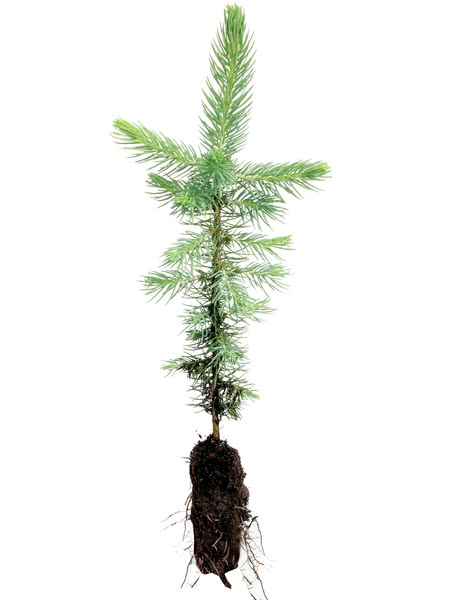
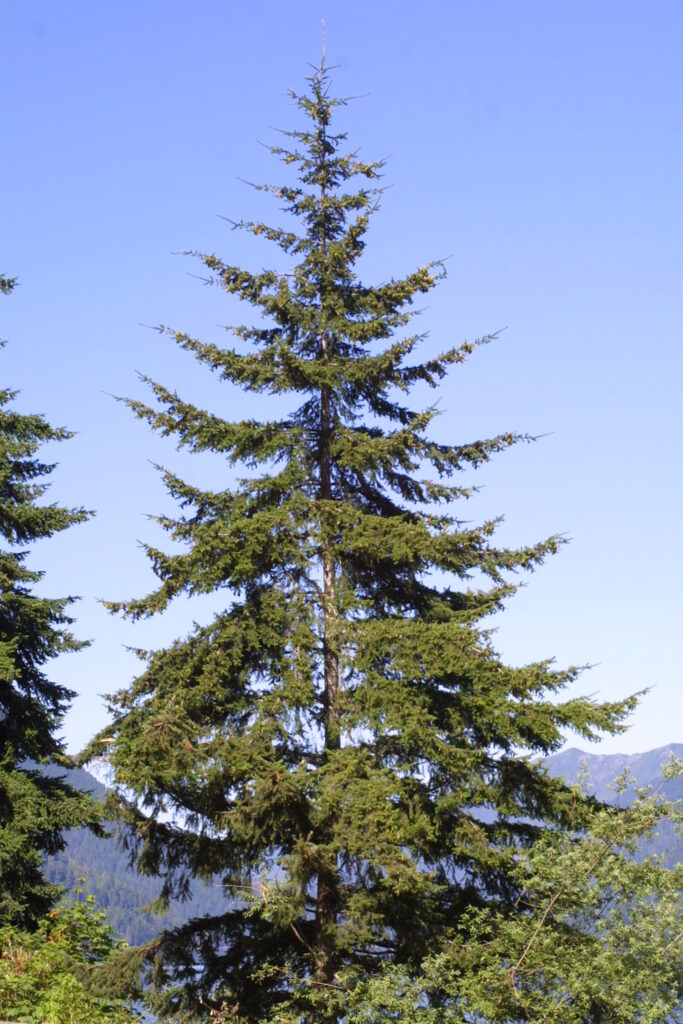
Full sun and partial shade are best for this tree, meaning it prefers a minimum of four hours of direct, unfiltered sunlight each day.
The Douglasfir prefers acidic or neutral soil that is well-drained, though it can also be found in its native habitat of rocky mountain slopes. It is sensitive to drought.
This tree does best on a roomy site with an abundance of atmospheric moisture and can be injured by high winds.
Douglasfir seeds are used by blue grouse, songbirds, squirrels, rabbits and other small animals. Antelope, deer, elk, mountain goats and mountain sheep eat the twigs and foliage. It provides excellent cover for a wide range of animals.
While the Douglasfir may have first been introduced to cultivation by botanist-explorer David Douglas in 1826, its importance to American history continues unabated. As well as being the country’s top source of lumber today, the Douglasfir also helped settle the West, providing railroad ties and telephone/telegraph poles.
Source: Arbor Day Foundation
Eastern Redcedar
(Arkansas, Georgia, Iowa, Kansas, Kentucky, Louisiana, Mississippi, Missouri, Nebraska, New Jersey, North Carolina, Ohio)
The eastern redcedar grows to a height of 40–50 feet and a spread of 8–20 feet at maturity and grows at a medium rate, with height increases of 13–24 inches per year.
Redcedars are unusually long-lived, with the potential to live over 900 years. The oldest tree reported, from West Virginia, is 940 years old!

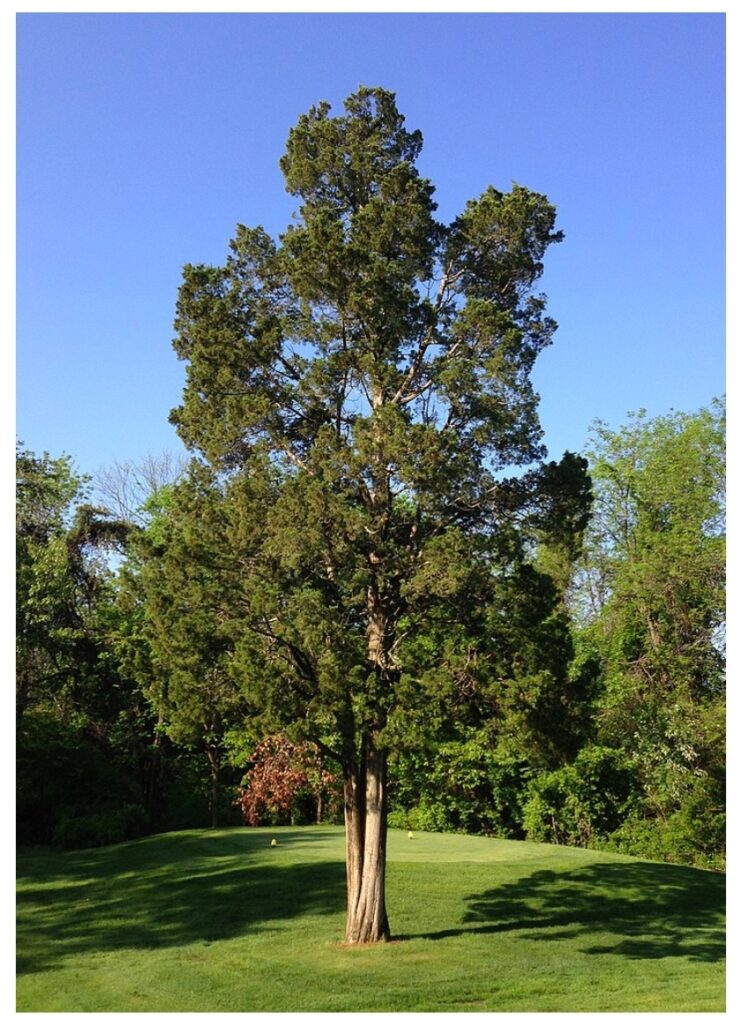
Full sun is the ideal condition for this tree, meaning it should get at least six hours of direct, unfiltered sunlight each day.
Redcedar foliage provides nesting and roosting cover for sparrows, robins, mockingbirds, juncos, and warblers.
The eastern redcedar is an ancient tree, dating back to aboriginal America.
Source: Arbor Day Foundation
Hackberry
(Connecticut, Illinois, Indiana, Rhode Island, South Dakota, Washington DC)
The hackberry is commonly heralded by tree experts as “one tough tree.” Found on a wide range of soils east of the Rockies from southern Canada to Florida, these trees thrive in a broad span of temperatures and on sites that vary from 14 to 60″ of annual rainfall. They can even stand up to strong winds and tolerate air pollution.
The hackberry grows well in a variety of soils. It has some tolerance for both flooding and drought.
All of this hardiness adds up to a good landscape choice, particularly if you’re looking for an energy-conserving shade tree that doesn’t require watering.
The hackberry grows to a height of 40–60 feet and a spread of 40–60 feet at maturity. This tree grows at a medium to fast rate, with height increases of anywhere from 13 inches to more than 24 inches per year.
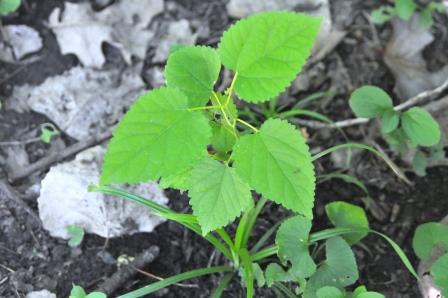
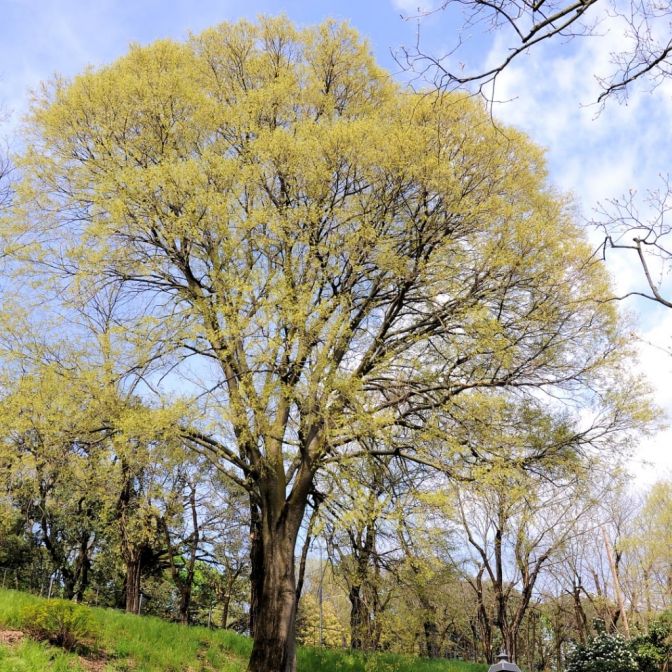
Full sun is the ideal condition for this tree, meaning it should get at least six hours of direct, unfiltered sunlight each day.
The hackberry forms characteristic corky ridges and warts on trunk and branches and tolerates strong winds, pollution, heat, drought, and salt.
It has a growth pattern that resembles the elm – without the susceptibility to disease.
The fruit of the hackberry is popular with winter birds, especially the cedar waxwing, mockingbird and robin. The tree also attracts many butterfly species including American snout, hackberry, mourning cloak, and tawny emperor.
Source: Arbor Day Foundation
Incense Cedar
(Arizona, California, Nevada)
Incense Cedar is a coniferous tree native to western North America.
As the name suggests, all parts of the tree are wonderfully aromatic.
It is a large tree, typically reaching heights of 100–130 feet. The largest known tree, located in Klamath National Forest, Siskiyou County, California, is 157 feet tall with a 39-foot circumference trunk and a 57 foot spread.
This is a fast-growing tree, adding at least 12 inches a year in its early years.
This tree can live to over 500 years old.
With its thick bark, the incense cedar is one of the most fire- and drought-tolerant plants in California.
Plant Incense Cedar in a sunny or lightly shaded area. It grows well in a wide range of soils, growing best in fertile and well-drained soils.
New plants should be kept moist for the first few years.
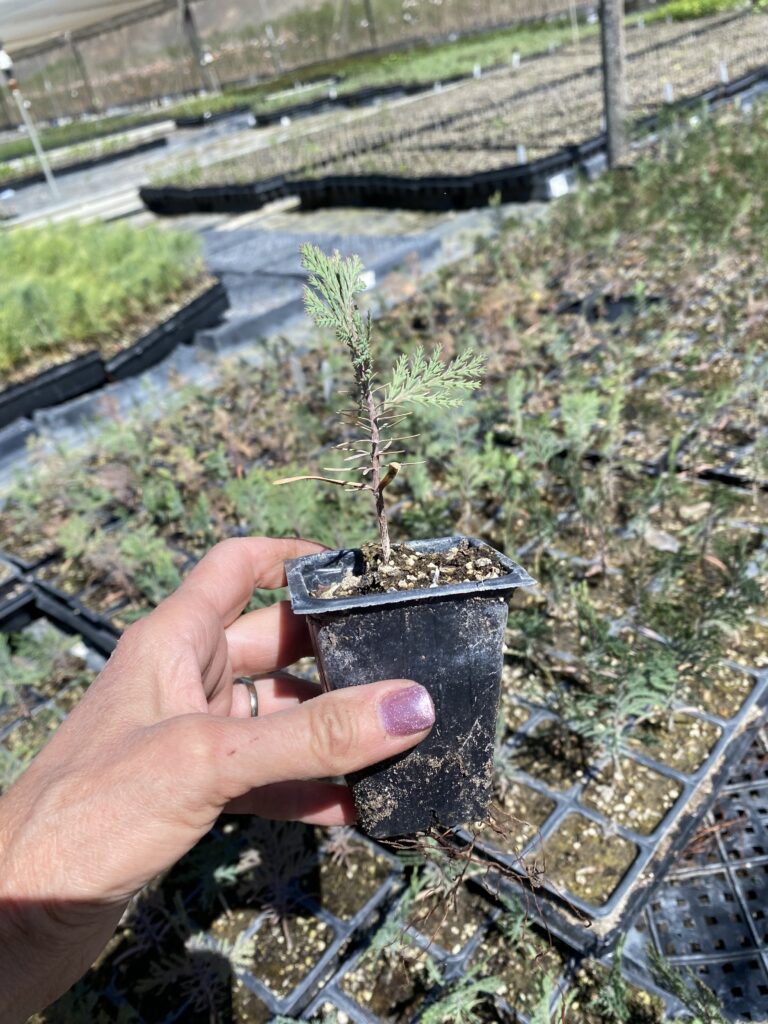
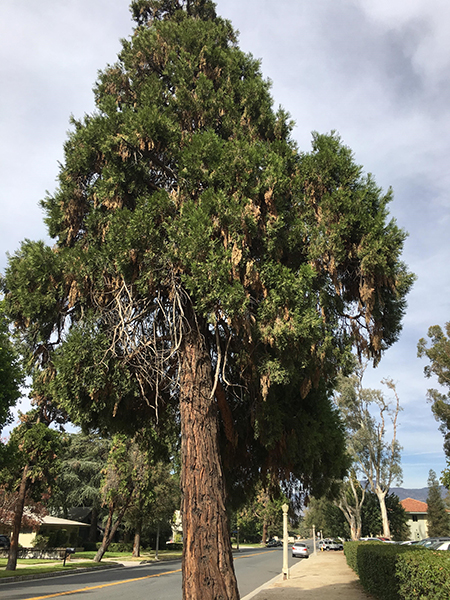
Indigenous people of California use the plant in traditional medicine, basket making, hunting bows, building materials, and to produce fire by friction. A Northern California tribe used branchlets to filter out sand from water when removing toxins from acorn meal; foliage also served as a flavoring.
The tree can be utilized for the creation of essential oils. Scientific studies have shown that these essential oils have the ability to lower the levels of microbes, such as bacteria and viruses.
Source: Wikipedia
Red Maple
(Alabama, Delaware, Florida, Maryland, South Carolina, Tennessee, Virginia, West Virginia)
The Red Maple brings color to your landscape year-round. Green stems turn red in winter, new leaves are red-tinged, turning to green. Fall color is deep red or yellow. Flowers are also red.
The Red Maple grows to a height of 40–60 feet and a spread of around 40 feet at maturity.
This tree grows at a medium to fast rate, with height increases of anywhere from 13 inches to more than 24 inches per year.
Full sun is the ideal condition for this tree, meaning it should get at least six hours of direct, unfiltered sunlight each day.
The Red Maple grows in acidic, loamy, moist, rich, sandy, silty loam, well-drained and clay soils. It prefers wet soil conditions but has slight drought tolerance.
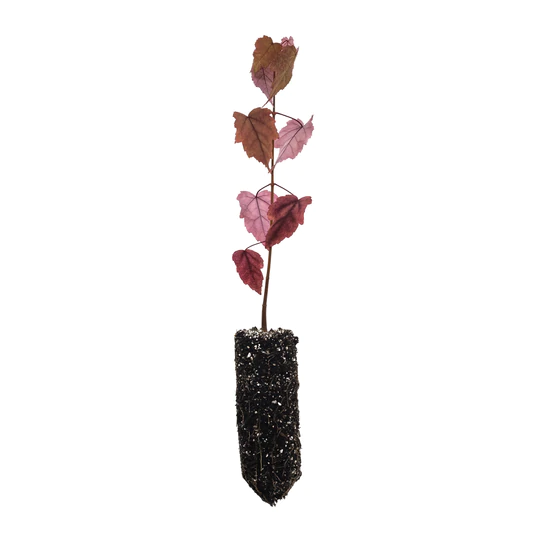
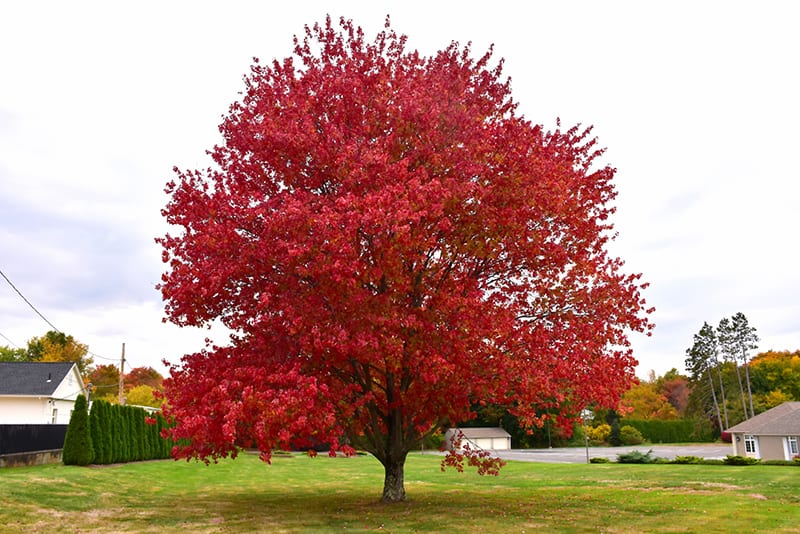
The fruits (samaras) provide food for squirrels and many other rodents. Rabbits and deer eat the tender shoots and leaves of red maples.
The Red Maple has many claims to fame, including the greatest north–south range of any tree species living entirely in the eastern forests (Newfoundland to southern Florida).
The nation’s largest Red Maple lies in Great Smokey Mountains National Park. This tree was declared champion in 1997 by American Forests and is listed in the National Register of Big Trees as being 141 feet tall and just over 7 feet in diameter.
Source: Arbor Day Foundation
Southern Magnolia
(Texas)
The Southern Magnolia has large, creamy white and very fragrant flowers that grace this broad-leafed evergreen in late spring and early summer. Leaves are shiny green, reddish underneath.
It blooms May through June, with some blossoms throughout the summer months.
The southern magnolia grows to a height of 60–80 feet and a spread of around 40 feet at maturity.
This tree grows at a slow to medium rate, with height increases of anywhere from less than 12-24 inches per year.
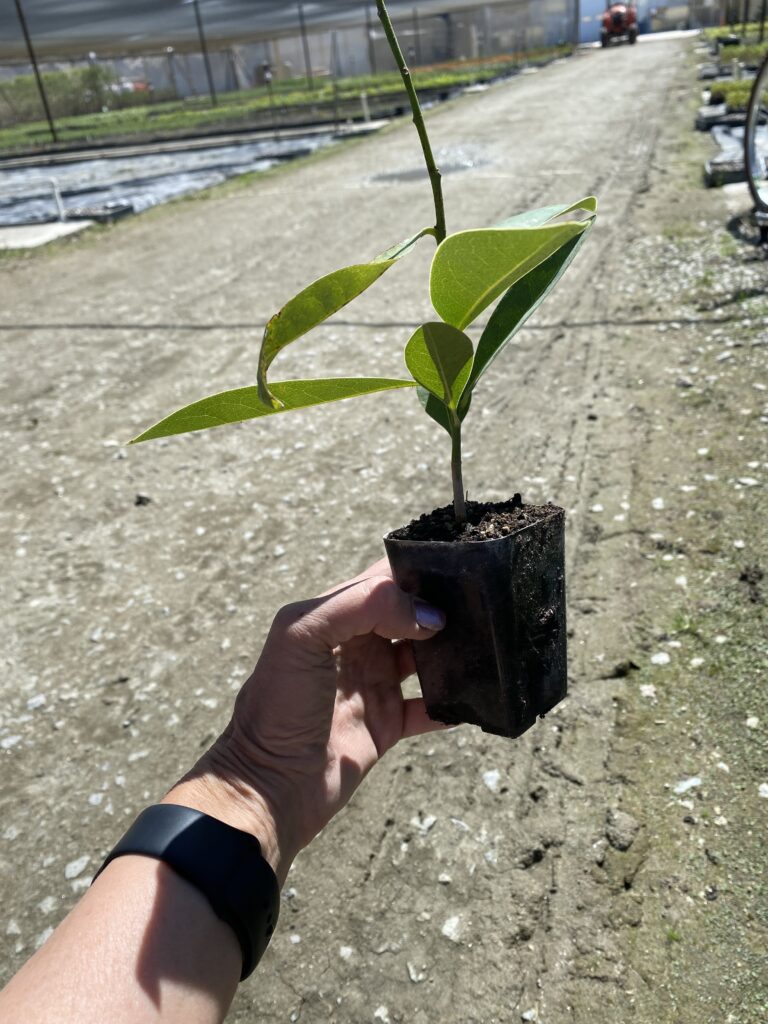
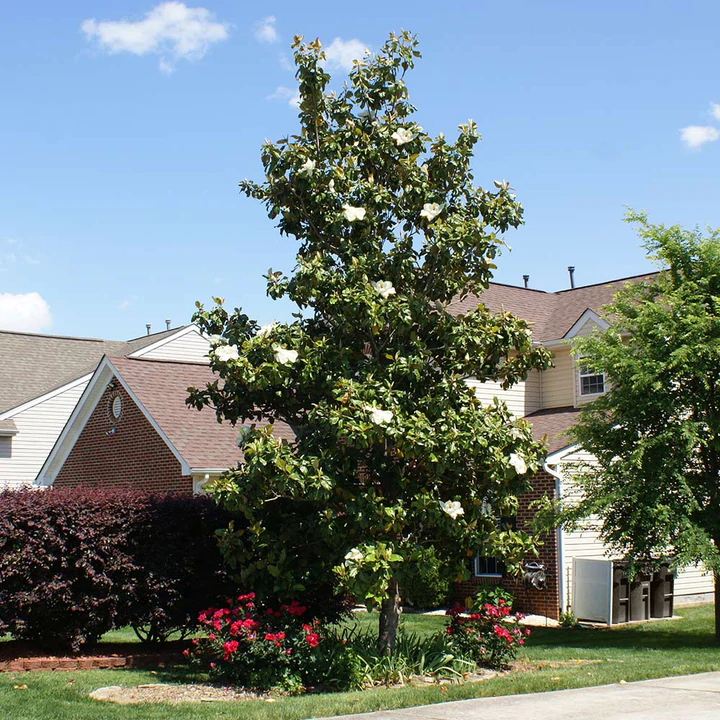
Full sun and partial shade are best for this tree, meaning it prefers a minimum of four hours of direct, unfiltered sunlight each day.
The southern magnolia grows in acidic, loamy, moist, sandy, well-drained and clay soils. It can withstand some flooding and has moderate drought tolerance.
The southern magnolia is an evergreen, keeping most (but not all) of its leaves year-round. It yields fruit that is 3–8″ long, attracting squirrels, rabbits and birds—including wild turkey.
The southern magnolia is better placed in landscaping rather than along a street due to the leathery leaves and large seed pods that are shed in the fall.
The name magnolia honors a French botanist, Pierre Magnol, who admired the tree so much that he transplanted it to Europe 300 years ago.
Source: Arbor Day Foundation
Tamarack
(Alaska, Maine, Michigan, Minnesota, New Hampshire, New York, Vermont, Wisconsin)
Neighborhood Forest is excited to bring the Tamarack to our list of species this year in honor of Tamarack District Library in Lakeview, Michigan, which was instrumental in helping us go viral last year.
One of the most beautiful trees in the far northern forests of North America is the colorful deciduous conifer, commonly called the tamarack.
The Tamarack is one of the few conifer trees that changes color and drops its needles in the fall / winter.
The species turns a dazzling yellow in the fall before dropping its needles to reveal attractive flaking bark in the winter months to have its needles re-emerge a blue-green hue for the spring and summer. Every year those lovely falling needles create a fine mulch that is pleasing to the eye and completely sustainable.
The Tamarack grows up to 40 to 80 feet tall and 15 to 30 feet wide.
This species of tree requires full sun. Tamarack trees are completely intolerant of shade, so it’s important to clear out competing trees or shrubs. Making sure that your tree can grow in direct sun should help to ensure it gets adequate spacing. Place it at least 15 feet from any other trees.
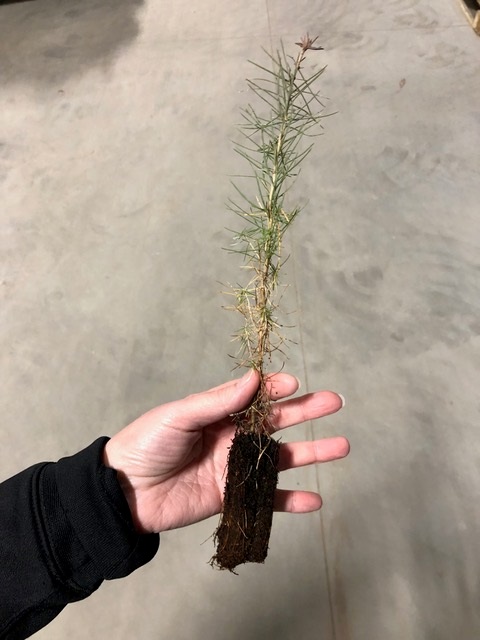
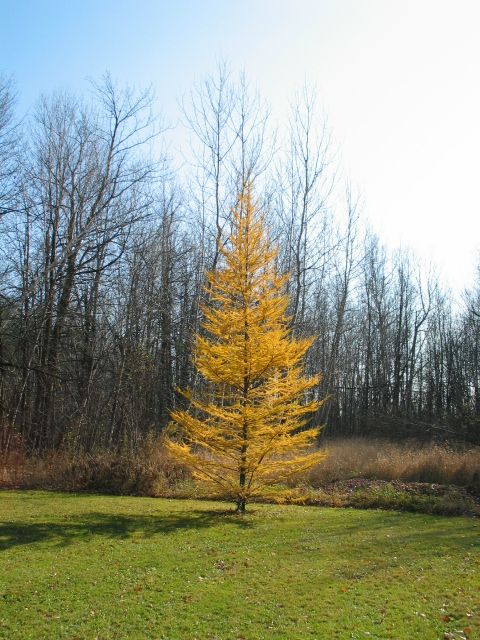
When you decide where to plant your tree, realize that this species does not like competition; it will require a good amount of space between it and any other trees to thrive.
In nature, tamaracks grow in wet areas such as bogs or swamps. Planting it in an area that gets moisture that replicates these conditions will be best for the tree. This is less important than providing ample sun but will cut down on your supplemental watering needs.
Wet, organic soil is best for Tamaracks. It is native to a type of bog called muskeg, which is comprised of peat. This rich wet acidic soil is preferred and will help your tree thrive, but as far as soil needs go, the tamarack is more adaptable here than it is for its sun requirements.
Tamarack trees require some supplemental water, especially during periods of drought and when the tree is first establishing itself. It will not tolerate being overly dry, so keeping the soil beneath it moist is important. On initial planting, adding two to three inches of good organic mulch to the dripline will help retain moisture. After a few seasons, you won’t need to add more mulch since the tree makes its own beautiful needle mulch.
During the first three years, it is important to give your tree water weekly. Follow the standard of 10 gallons per inch of trunk diameter measured by caliper at knee height. If the weather is really dry, increase the water to 15 gallons—the tamarack won’t mind!
Source: TheSpruce.com
White Birch
(Massachusetts, Pennsylvania)
Beauty and romance may be the first images many people associate with the gleaming white paper birch. But this symbol of the north country has earned its place in history as a continuously useful tree that has served North Americans since the earliest days of human activity.
Today it is one of the best-loved trees of the New England landscape, planted often for the beauty of its distinctive bark and golden fall color.
The white birch (also known as paper birch) grows to a height of 50–70 feet and a spread of around 35 feet at maturity.
This tree grows at a medium to fast rate, with height increases of anywhere from 13 inches to more than 24 inches per year.
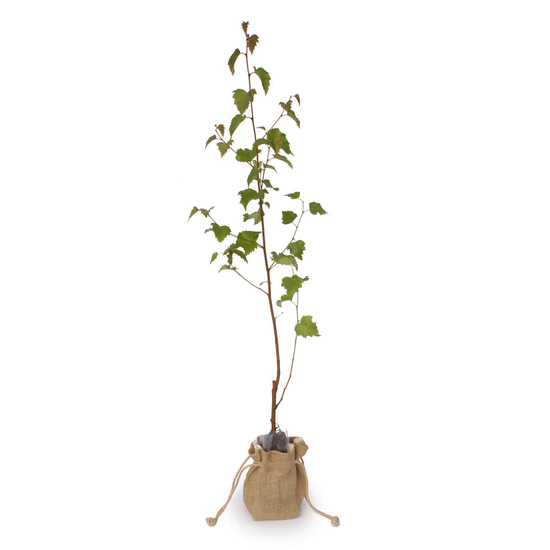
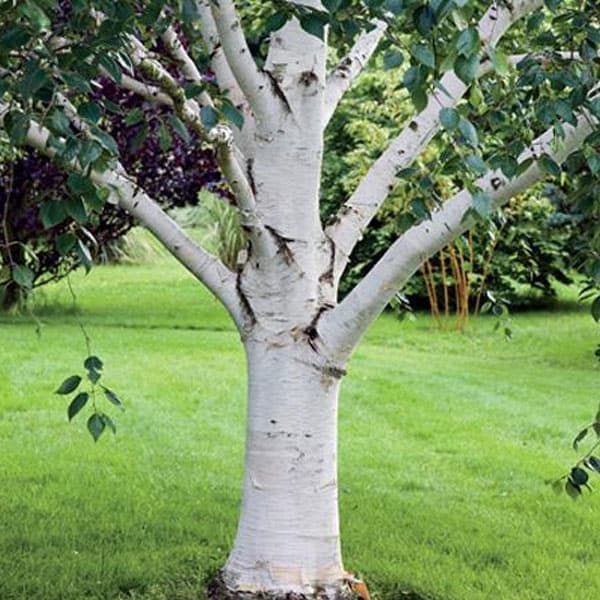
Full sun and partial shade are best for this tree, meaning it prefers a minimum of four hours of direct, unfiltered sunlight each day.
The paper birch grows well in acidic, loamy, moist, sandy, well-drained and clay soils. While it prefers normal moisture, the tree has some drought tolerance.
This tree develops a smooth white bark that curls and peels (once mature), provides bright yellow fall color, and produces brown or green catkins in April and May.
The white birch received its name from the nature of its bark. Long ago, people would peel layers of the thin, paper-like bark and write on it as a way to send messages. Sometimes known as canoe birch—recalling its favor among Native Americans and early fur trappers as a resource for sleek, sturdy, and lightweight watercraft.
Source: Arbor Day Foundation
White Spruce
(Ontario, Canada)
The white spruce grows to a height of 40–60 feet and a spread of 10–20 feet at maturity. This tree grows at a medium rate, with height increases of 13–24 inches per year.
This tree thrives in a lot of sunlight – ideally six hours of direct sunlight per day. The white spruce grows well in a variety of different soils and has some drought tolerance.
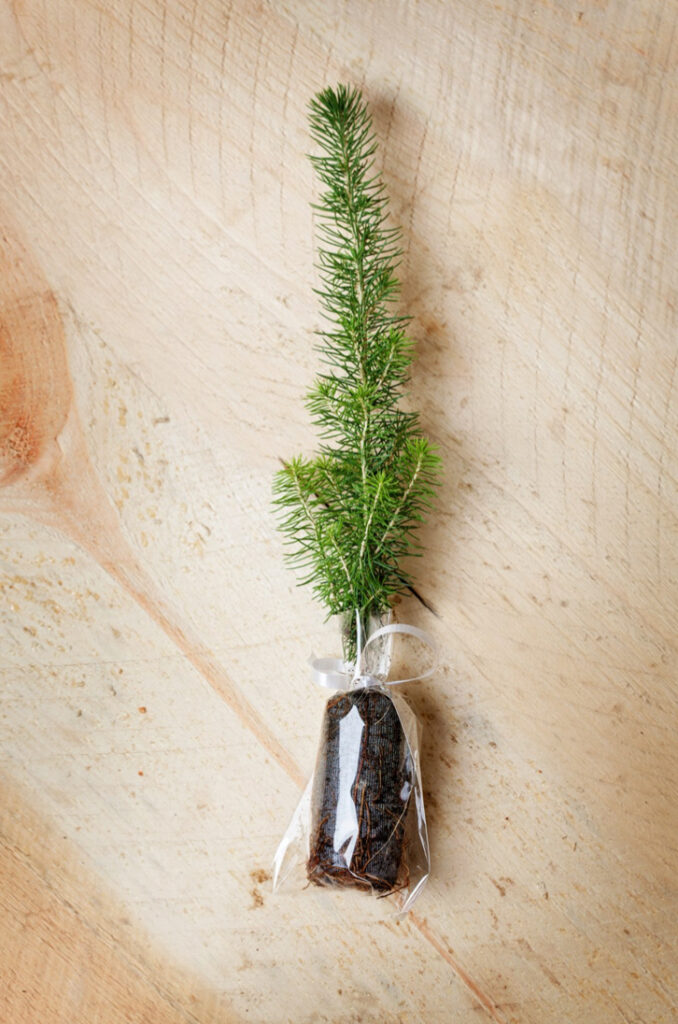
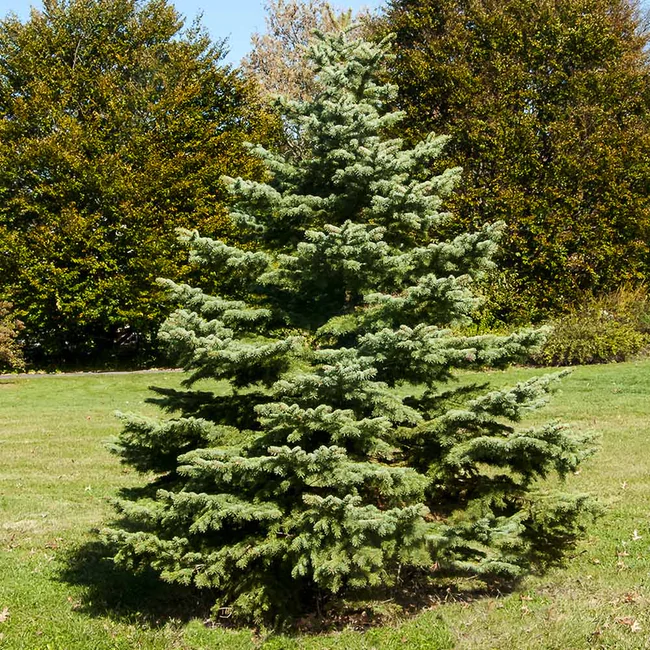
The white spruce does well when transplanted. It can withstand wind, heat, cold, drought, crowding, and some shade. It does well in cities and often serves as rural windbreaks.
Aside from providing nesting for birds and shelter for other animals, white spruces provide food for many kinds of wildlife. Crossbills, evening grosbeaks, and red-breasted nuthatches feed on its seeds. The foliage is eaten by grouse, rabbits, and deer. Red squirrels bite open cones to eat the seeds, and they delight upon young, tender spruce shoots.
When Jacques Cartier sailed up the broad St. Lawrence River in 1535, he became the first European to see North America’s white spruces. As he laid claim to the lands he beheld, he proclaimed them to be “as beautiful…as one could wish for.” The trees, he said, were “the finest trees in the world.”
Source: Arbor Day Foundation
Please check out our planting instructions and “Science of Trees” curriculum here.
Something Wonderful is Happening!
March 16, 2021
Dear Friends of Neighborhood Forest,
We have some very exciting new developments to share as we enter our 12th annual free tree giveaway.
I know it has been a tough and unfathomable 12 months for the entire world. A couple of years ago, even before all the craziness, we thought about calling it quits. Things were hard. Things were not moving as we expected. We wondered if our efforts were really making a difference.
Then, we started to get photos like this:
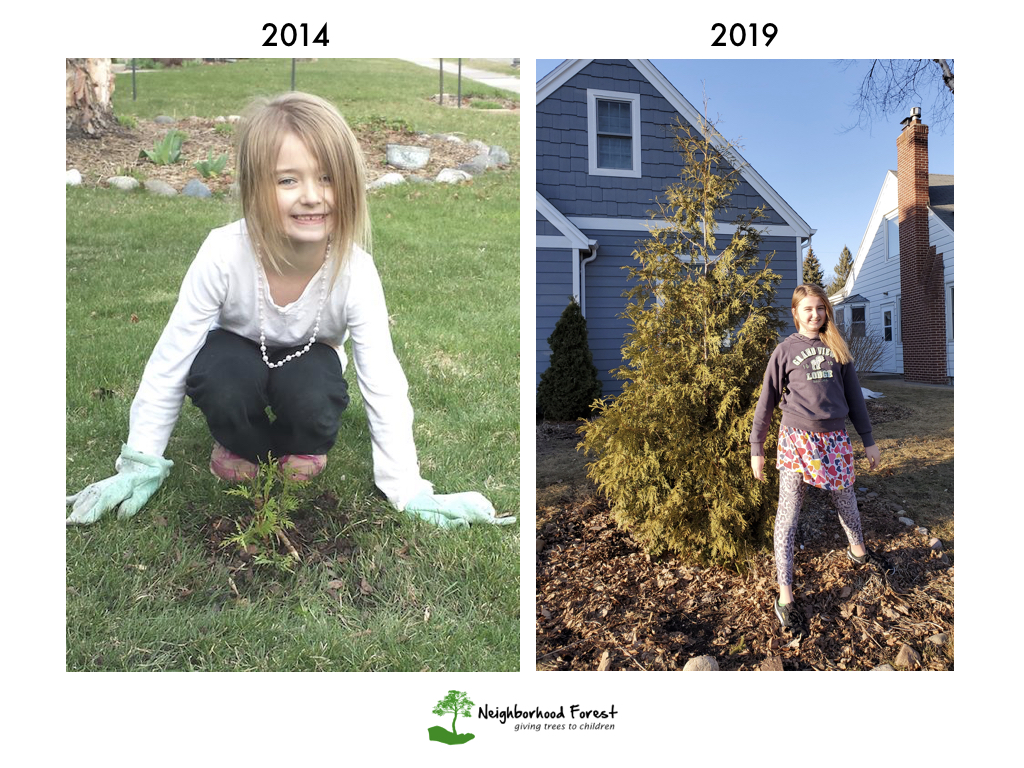
And this:
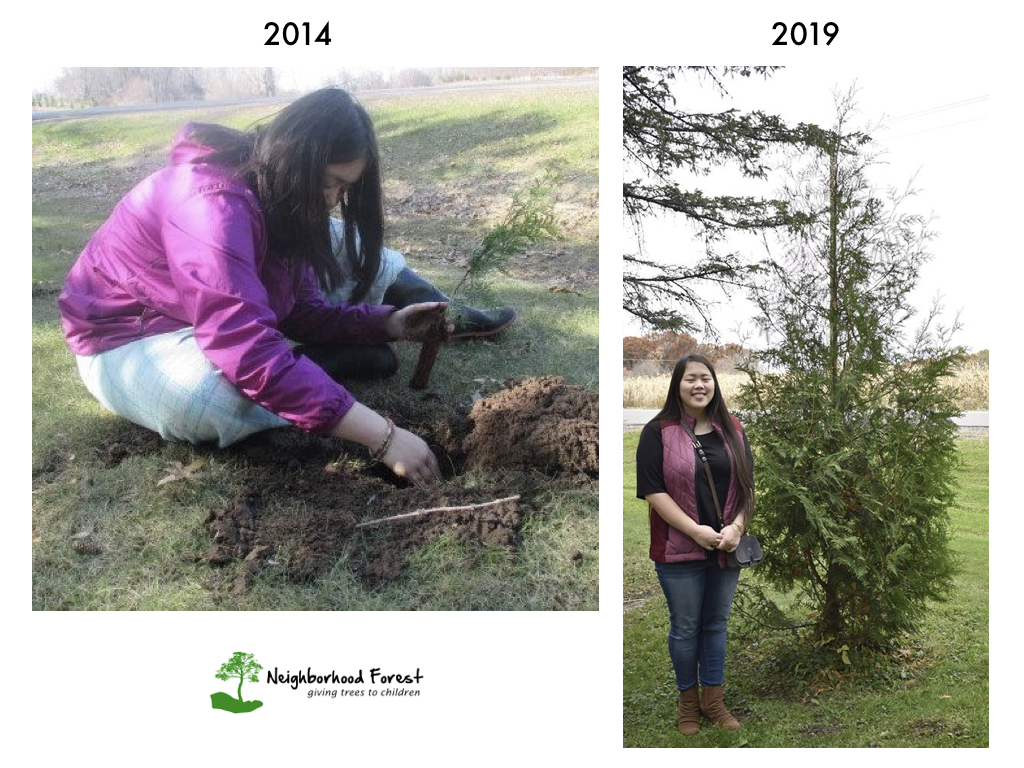
And, we were like, “we can’t give up now!”
I am so glad we didn’t give up because something wonderful and amazing is happening – right now.
In the past few weeks, we have experienced an incredible, unprecedented, and exhilarating surge of interest in our program, thanks to a small and unassuming library in Michigan!
In the first 11 years of our program, we grew from serving 4 schools in Minneapolis to 150 schools in 14 states – about 10-15 new schools per year. It was a fairly slow and steady growth over one decade.
In the past few weeks, we have nearly tripled – adding 250 new institutions – now serving over 400 organizations in 30 states!!
Here’s how it happened…
Three weeks ago, Tamarack District Library in Lakeview, Michigan got wind of our program and asked if they could also participate – they wanted to give trees to the kids they serve.
We had never had a request like this before and even though it was out of the ordinary, we thought, why not? What difference does it make whether we reach kids through schools or libraries? They signed up and became the first library in the nation to offer trees to kids via Neighborhood Forest. They were super excited about this and shared our program with a coop of libraries that they are a part of. Within a day or so, we had 5 libraries signed up in Michigan.
Then, they shared our program in a Library Programming group on Facebook and we essentially went viral – doubling the number of organizations we were serving – in just a few days!
Holy tree roots!
Below is the growing list of libraries, schools, and youth groups that have signed up since Tamarack changed the course of our destiny!
(By the way, we’ve given out Tamarack trees in the past, so this is just so fitting!)
It was all very unexpected, thrilling, and a bit overwhelming. This was the moment we had been waiting for all these years. The moment when people would be clamoring from all over to give trees to kids.
We now have the demand for trees we’ve been hoping for and we need to meet it with adequate fundraising. Obviously, this was a growth spurt we hadn’t really planned for.
Our program runs through the generosity of our amazing sponsors: https://www.neighborhoodforest.org/our-sponsors/
It costs us about $5 per tree or child.
Consider for a moment, that the average American family creates an annual carbon footprint that is equivalent to what 75 trees sequester in their lifetime. So, for about a dollar a day, Neighborhood Forest can offset a family’s carbon footprint by planting trees through the hands of children – now, tens of thousands of children!
Our sponsorship levels are as follows:
One Child $5 – 1 free tree for a child
Carbon Neutral Individual $75 – 1 year carbon neutrality for one person (15 free trees)
Carbon Neutral Family $375 – 1 year carbon neutrality for your family (75 free trees)
Maple $950 – 1 school / library (200 free trees)
Oak $2,500 – 3 schools / libraries (500 free trees)
Sequoia $4,950 – 8 schools / libraries (1,000 free trees)
Forest Builder $25,000 – 50 schools / libraries (5,000 free trees)
We can receive payment via Venmo or PayPal (or check) and we can provide a tax-deductible receipt if desired.

Would you or someone you know (an individual, business, or organization) be interested in supporting us this year, given the wonderful, unexpected surge in participation? Every little bit helps!
Feel free to spread the word!
Is your child’s tree still alive? Please share a current photo of it with your child(ren) on our Facebook page – we love collecting “then and nows” of the kids and their trees.
Thank you so much!
~ Happy Spring ~
Warmly,
Vikas
____________________________
Vikas Narula
Founder
Neighborhood Forest
5244 Zenith Ave. South
Minneapolis, MN 55410
www.neighborhoodforest.org
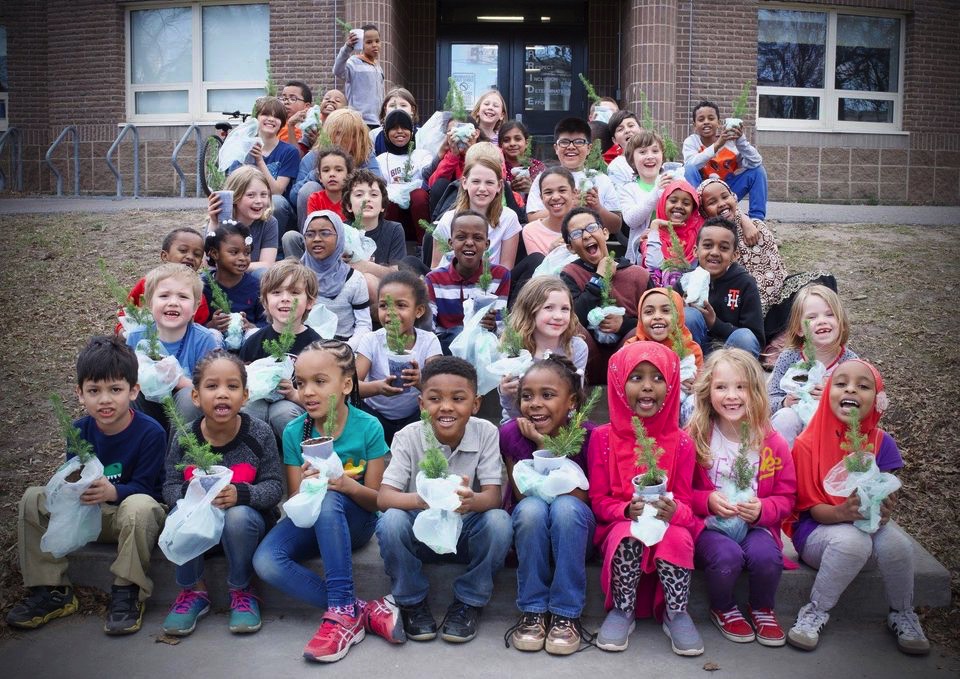
New schools, libraries, and youth groups that have joined Neighborhood Forest in the past three weeks!
Tamarack District Library, Lakeview, MI
Diamond Path International School, Apple Valley
Darby Creek, Hilliard, OH
Lakeview Elementary, Lakeview MI
Big Rapids Community Library, Big Rapids MI
Bellaire Public Library, Bellaire MI
Manistee County Library, Manistee, MI
Leelanau Township Library, Northport MI
JFK Elementary, Kingsport, TN
Wildflower Early Learning Center, Savage MN
Keystone Elementary, LaGrange, OH
Bridge Prepatory Charter School, Staten Island, NY
White Cloud Community Library, White Cloud, MI
PS 380 John Wayne Elementary, Brooklyn, NY
PS 35 Clove Valley, Staten Island, NY
Zane North School, Collingswood NJ
BSA Pack 2 Westerleigh (Scouts), Staten Island, NY
Endeavor Library, Montello WI
Darlington Library, Darlington, SC
Beacon Falls Public Library, Beacon Falls CT
Normandale Elementary School, Edina
Keene Public Library, Keene New Hampshire
Knox Public Library, Knox PA
Philmont Public Library, Philmont, NY
Ashby Free Public Library, Ashby MA
Joint Base Myer-Henderson Hall Library, Fort Meyer, VA
Vestal Public Library, Vestal NY
Murrieta Public Library, Murrieta CA
DR Evarts Library, Athens, NY
Bellevue Public Library, Bellevue, ID
Hundred Public Library, Hundred, WV
Tom Green County Public Library, San Angelo TX
Butler Area Public Library, Butler PA
Veterans Memorial Library St. Cloud Branch, St. Cloud, FL
Oakland City-Columbia Twp. Public Library, Oakland City, IN
Liberty Lake Library, Liberty Lake, WA
Star Valley Branch Library, Afton WY
Tyler Public Library, Tyler TX
Barnwell County Public Library, Barnwell SC
Regency Park Branch Library, New Port Richey FL
Mitchellville Public Library, Mitchellville IA
Porter Memorial Library, Blandford MA
Amery Area Public Library, Amery WI
Bartholomew County Public Library, Columbus IN
Alvah N Belding Memorial Library, Belding MI
Brisbane School District, Brisbane CA
Elmont Memorial Public Library, Elmont NY
Three Oaks Township Public Library, Three Oaks MI
Kewaunee Grade School, Kewaunee WI
Rapides Parish Library, Alexandria LA
Carnegie Library of Homestead, Munhall PA
Olive Free LIbrary Association, West Shokan NY
Wickliffe Public Library, Wickliffe OH
Lebo Branch Library, Lebo KS
Kalamazoo Public Library, MI
Mercer County Public Library, Harrodsburg KY
New River Public Library, Wesley Chapel FL
Pike County Public Libraries – Phelps Branch KY
Clayton County Morrow Library, Morrow GA
Buchanan Elementary School PTA, Murrieta CA
Emily Brittain Elementary School, Butler PA
Collingswood Middle School, Collingswood NJ
Unicoi County Public Library, Erwin TN
Tangier Smith Elementary, Mastic Beach NY
Ida Public Library, Belvidere IL
Leighton Township Library, Wayland MI
Hoffman Trails Elementary, Hilliard OH
Benson Memorial Library, Titusville PA
Anderson-Lee Library, Silver Creek NY
Malta Township Public Library, Malta IL
Evans City Public Library, Evans City PA
Chester Public Library, Chester CT
W.G. Rhea Public Library, Paris TN
Juniata County Library, Mifflintown PA
Cromwell Belden Public Library
Glen Ellyn Public Library, Glen Ellyn IL
Novel Academy, Lake Elsinore CA
Lima Public Library, Lima OH
Southside Elementary, Shelbyville KY
Cranberry Public Library, Cranberry Township PA
Glen Lake Community Library, Empire MI
Belen Public Library, Belen NM
Brandon Free Public Library, Brandon VT
Red Bank Public Library, Red Bank NJ
Young Men’s Library Association, Ware MA
Pike County Public Library, Pikeville KY
Pike County Public Libraries, Phelps KY
Cass District Library, Cassopolis MI
Butler Catholic School, Butler PA
Slippery Rock Community Library, Slippery Rock PA
Lincoln County Library, Kemmerer WY
Crowne Hill Elementary School, Temecula CA
Prospect Community Library, Prospect PA
Owensville Carnegie Public Library, Owensville IN
Missoula Public Library, Missoula MT
Ventress Memorial Library, Marshfield, MA
Rock Falls Public Library District, Rock Falls IL
Early Learning Connections, Butler PA
Chippewa Falls Public Library, Chippewa Falls WI
Amazing Grace Worship youth, Sidney KY
Saegertown Area Library, Saegertown PA
Union Public Library, Union NJ
Girl Scouts of Minnesota and Wisconsin Lakes and Pines Troop 661, Sartell MN
Northland Public Library, Pittsburgh PA
Stillwater County Library, Columbus MT
Salem Public Library, Salem VA
Albert Chapman Elementary School, Powell OH
Elkhorn City Elementary, Elkhorn City KY
Reed City Area District Library, Reed City MI
Middletown Public Library, Middletown RI
The Goddard School Beachwood, Beachwood OH
CubScouts pack 614, Murrieta CA
HIS Kids Christian School, Butler PA
Western Elementary School, Centertown KY
Verndale Area Christian Academy, Verndale MN
Wood Family Home School, Afton WY
Taunton Public Library, Taunton MA
Plymouth Public Library, Plymouth MA
McKinley Memorial Library, Niles OH
Carver Memorial Library, Searsport ME
Washington Elementary School, Dublin OH
Hamilton Public Library, Hamilton NY
Riverview Elementary/ Middle School, Grundy VA
Central Middle School, Golden IL
Slater Public Library, Slater IA
Interstate 35 Elementary School, Truro IA
Leelanau Montessori Public School Academy, Lake Leelanau MI
Girl scout troop 71303 gsmh – Weir KS
Carolina International School – Concord NC
Lillian C. Schmitt Elementary – Columbus IN
Bright Horizons at Tel Hai, Honey Brook PA
Pasadena Public Library – Pasadena TX
PS 44 Thomas C Brown, Staten Island NY
La Barge Branch Library, La Barge WY
Warrior Run Middle School – Turbotville PA
Sutton County Public Library – Sonora TX
Jasper County Public Library Rensselaer Branch, Rensselaer IN
Little Dixie Regional Libraries – Moberly MO
Geary Elementary Middle School – Left Hand WV
Fairview Elementary – Richmond IN
Lawrence Memorial Library, Bristol VT
Christina’s Daycare, Dixon IL
Barrett Elementary, Homestead PA
BSA Troop 1907, Houston TX
Lewis Cooper Jr. Memorial Library – Opelika AL
Lincoln Public Library – Lincoln CA
Pasco County Libraries – Hudson FL
Land O’Lakes Library – Land O’Lakes FL
Centennial Park Library – Holiday FL
Columbia County Public Library – Lake City FL
South Holiday Library – Holiday FL
Navigator Academy of Leadership – Valrico FL
Twin Falls Public Library – Twin Falls ID
Zion Benton Public Library – Zion IL
Girl Scouts Earth Day Event – Quincy IL
Evergreen Park Public Library – Evergreen Park IL
Peoria Public Library – Peoria IL
Edwardsville Public Library – Edwardsville IL
Seneca Public Library District – Seneca IL
Jasper County Public Library – DeMotte IN
South Whitley Community Public Library – South Whitely IN
Ligonier Public Library – Ligonier IN
Covington Public Library – Covington IN
Brook Iroquois Washington Public Library – Brook IN
Jasper County Public Library – Wheatfield IN
Churdan Public Library – Churdan IA
McCreary Public Library – Whitley City KY
Weymouth Elementary School – Morrill ME
Ames Elementary School – Searsmont ME
Washington County Free Library – Hagerstown MD
Berkshire Athenaeum – Pittsfield MA
Community District Library – Coldwater MI
Community District Library – Bancroft MI
Community District Library – New Lothrop MI
Community District Library – Byron MI
Community District Library – Lennon MI
Community District Library – Morrice MI
Community District Library – Corunna MI
Lapeer District Library – Lapeer MI
Pearl River County Library System – Picayune MS
The Paris Dulaney Memorial Library – Paris MO
Paris Elementary – Paris MO
Montgomery Co R-II Middle School – Montgomery City MO
St. Francis Catholic School – Billings MT
Kimball Public Library – Kimball NE
Butler Memorial Library – Cambridge NE
First Congregational UCC – Albuquerque NM
Sidney Memorial Public Library – Sidney NY
Cazenovia Public Library – Cazenovia NY
Kingston Library – Kingston NY
Kent Public Library – Kent Lakes NY
Cub Scout Pack 123 – Jamestown NY
Phoenicia Elementary School – Phoenicia NY
Maxwell Memorial Library – Camillus NY
Sharon Hill Daycare and Preschool – Cincinnatti OH
North Canton Public Library – North Canton OH
Girl Scout Troop #796 of Ohio’s Heartland – Dublin OH
Scottish Corners Elementary – Dublin OH
Franklin Public Library – Franklin PA
Southmoreland Primary Center – Alverton PA
Vandergrift Public Library – Vandergrift PA
Hollidaysburg Area Public Library – Hollidaysburg PA
Troop/Pack 217 – Chicora PA
West Mifflin Middle School – West Mifflin PA
Chippewa Branch Library – Beaver Falls PA
Chicora Elementary School – Chicora PA
West Warwick Public Library – West Warwick RI
Johnsonville Public Library – Johnsonville SC
Dell Rapids Carnegie Public Library – Dell Rapids SD
Victoria Public Library – Victoria TX
Bent Northrop Memorial Library – Fairfield VT
Alburgh Public Library – Alburgh VT
Readsboro Community Library – Readsboro VT
Denmark Early Childhood Center – Denmark WI
Grantsburg Public Library – Grantsburg WI
Lakeview Community Library – Random Lake WI
Alpine Branch Library – Alpine WY
Celebrating 10 Years of Neighborhood Forest
We are celebrating 10 years of Neighborhood Forest this spring! What we are really celebrating is our Earth, the beautiful trees, our children, and the magic of planting and watching trees grow.
Now that we have been around a decade, we are starting to harvest and gather inspiring “then and now” photos of the kids with their trees (see below).
These photos and stories are bringing us joy and inspiration and giving us the much-needed soul fuel to keep going and growing.
If you have a “then and now” (or even now) photo, which you would like to share, please feel free to share directly on our Facebook page.
It would make our 10th anniversary that much more special.

Since 2010, Neighborhood Forest has reached over 100 schools, 60,000 families, and planted over 30,000 (mostly residential and urban) trees through the hands of children and parents across America and Canada.
When we see these photos of kids with their trees, we are inspired to reach even more schools and children. We would like to reach every child in North America and, eventually, the world.
We are looking for ideas, resources, sponsors, and partners to help us get there. We are looking to invest in our website, back-end technology, and logistics platform to help us scale our operation to reach as many children as possible.
We appreciate and welcome your support!

Investment to plant an urban tree through the hands of a child and their parents via Neighborhood Forest:
$2-$10
Health, environmental, and economic benefits from one urban tree over its lifetime:
$30,000-$70,000
Getting to plant and watch a tree grow from seedling to maturity:
Priceless
Thank you for working with us all these years to make this an incredibly rewarding and heart-warming experience that will continue to pay dividends for decades to come.
